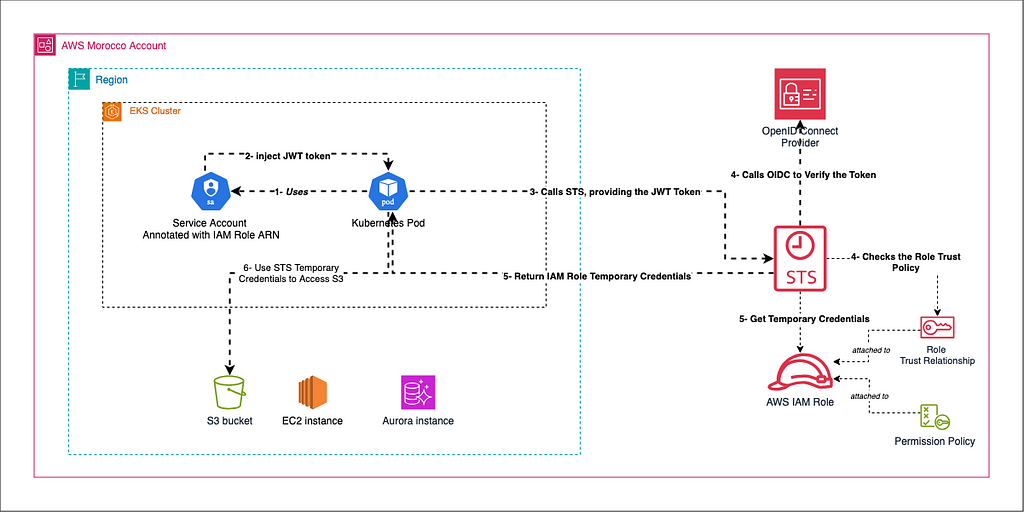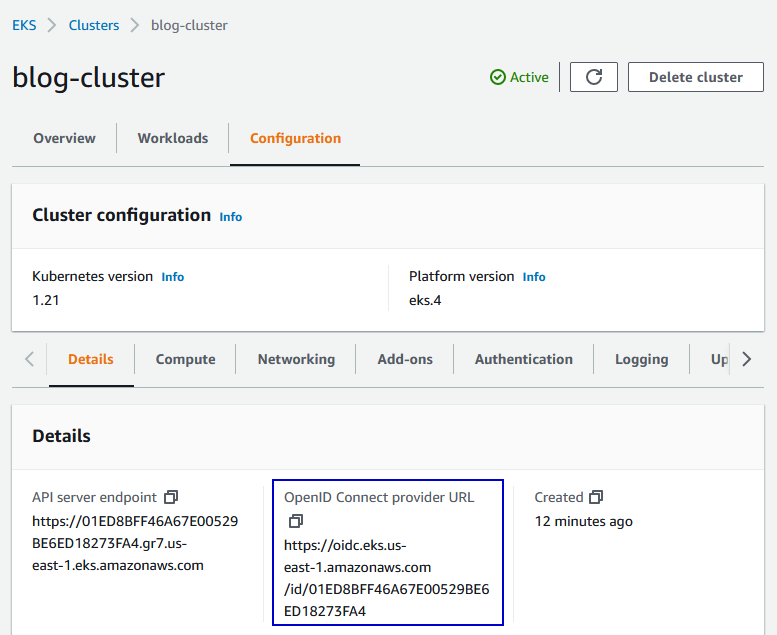In the world of Kubernetes and AWS, managing access to AWS resources from your Kubernetes cluster can be tricky. That’s where AWS IAM Roles for Service Accounts (IRSA) comes in — a feature that helps bridge the gap between Kubernetes and AWS, providing a secure and efficient way to grant AWS permissions to your Kubernetes workloads. This article explains what IRSA is, why it’s important and how to configure it in your Amazon EKS cluster.
Understanding AWS IAM Roles for Service Accounts
Traditionally, to give Kubernetes pods access to AWS resources, you would attach an IAM role to the EC2 instances in your cluster. However, this approach has limitations:
- All pods on a node share the same IAM role.
- Pods might have more permissions than necessary, violating the principle of least privilege.
Another solution involves creating IAM users, generating access keys, and mounting these keys to your pods. While this offers more granular control, it also presents challenges:
- It’s not Kubernetes-native, potentially complicating deployments and management.
- It requires careful code maintenance to ensure secure mounting of credentials.
- Managing short-lived credentials can be challenging. (For more details on this, refer to this article.)
IRSA solves these problems by allowing you to associate an IAM role with a Kubernetes service account. This means:
- You can have fine-grained access control at the pod level. - Different pods on the same node can have different IAM roles. - You can manage AWS permissions using native Kubernetes concepts.
How IRSA Works
IRSA leverages OpenID Connect (OIDC) for authentication. Here’s a simplified flow on how it works:
- You set up the OIDC provider for the EKS cluster in AWS IAM.
- You create an IAM role with necessary permissions and configure its trust relationship to allow assumption by the Kubernetes service account.
- You create a Kubernetes service account and annotate it with the IAM role ARN.
- You create a pod specification that uses this service account.
- Kubernetes creates the pod and injects the service account’s JWT token into it.
- The pod starts, and an application within it needs to access an AWS resource.
- The application calls the AWS STS service, providing the JWT token.
- AWS STS verifies the token with the OIDC provider and checks it against the IAM role’s trust policy.
- If valid, AWS STS returns temporary AWS credentials to the pod.
- The application uses these temporary credentials to access AWS resources as permitted by the IAM role.
- The credentials expire after a short period, and the process repeats from step 7 when new credentials are needed.

Setting Up IRSA
Let’s go through the steps to set up IRSA in your EKS cluster:
1 — Set up an OIDC provider for your EKS cluster
This step is crucial and often overlooked. You need to create an IAM OIDC identity provider that corresponds to your EKS cluster’s OIDC issuer URL.
Get the OIDC issuer URL
| |
Or you can retrieve from the EKS console

Then create the IAM OIDC identity provider :
2 — Create an IAM role
Now, create an IAM role that your Kubernetes service account will assume. The trust policy should look like, save it to a file trust-policy.json
| |
Now create the role and specify the trust policy above:
| |
And then attach the necessary policies you want to IAM role to have, for
example here we want to have a Read Only access to all s3 buckets in the
account using the AWS managed policy arn:aws:iam::aws:policy/AmazonS3ReadOnlyAccess
| |
3 — Create a Kubernetes service account
Create a service account in your Kubernetes cluster and annotate it with the IAM role ARN you created previously in step 2 — .
4 — Use the service account in your pod
Finally, use this service account in your pod specification:
5 — Verifying the Setup
To verify that IRSA is working correctly:
- Deploy a pod using the service account you created.
| |
- Exec into the pod and use the AWS CLI to try accessing the resources you’ve granted permissions for.
| |
6 — Use Terraform
You can use this module to create the IRSA role properly and attach the policies you need to them.
terraform-aws-iam/modules/iam-role-for-service-accounts-eks
Conclusion
AWS IAM Roles for Service Accounts provide a powerful way to manage AWS permissions for your Kubernetes workloads. By following the steps outlined in this guide, you can set up IRSA in your EKS cluster and enjoy more granular, secure access control. Remember, the key to a successful IRSA setup lies in properly configuring the OIDC provider and creating well-defined IAM roles and Kubernetes service accounts.
AWS IAM Roles For Kubernetes Service Accounts(IRSA) was originally published in AWSMorocco on Medium, where people are continuing the conversation by highlighting and responding to this story.
The content, views, and opinions expressed on this blog, awsmorocco.com, are solely those of the authors and contributors and not those of Amazon Web Services (AWS) or its affiliates. This blog is independent and not officially endorsed by, associated with, or sponsored by Amazon Web Services or any of its affiliates.
All trademarks, service marks, trade names, trade dress, product names, and logos appearing on the blog are the property of their respective owners, including in some instances Amazon.com, Inc. or its affiliates. Amazon Web Services®, AWS®, and any related logos are trademarks or registered trademarks of Amazon.com, Inc. or its affiliates.
awsmorocco.com aims to provide informative and insightful commentary, news, and updates about Amazon Web Services and related technologies, tailored for the Moroccan community. However, readers should be aware that this content is not a substitute for direct, professional advice from AWS or a certified AWS professional.
We make every effort to provide timely and accurate information but make no claims, promises, or guarantees about the accuracy, completeness, or adequacy of the information contained in or linked to from this blog.
For official information, please refer to the official Amazon Web Services website or contact AWS directly.